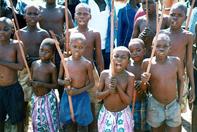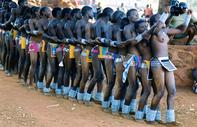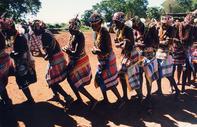Development of the Individual
The development of the individual was seen as a series of phases, puberty and marriage marking important stages. The transition from one to the next was made possible by external forces - the ancestors, good and evil spirits, witches of both sexes, which could exert good or bad influences on people. Initiation schools instructed initiates about what to expect and how to behave in the next stage.

Through ceremonies and dances, they could break with the mistakes of the past and embrace the future. The ceremonies also invoked the support of the ancestors and strengthened the initiates through magic. Held at, or near, the villages of mahosi and magota when there were sufficient participants, they did not necessarily occur every year.
A Venda girl attends three major initiation schools: vhusha at puberty; tshikanda, to reinforce the vhusha; and dombani, a premarital school. In the past, boys who had been through the thondo also attended parts of the dombani, but today very few do, and the boys' schools, vhutuka and thondo, are obsolete. Most attend murundu, introduced at a later stage. It takes place outside the village, usually on a hill or mountain, in the dry winter months, to aid in the healing of the circumcision wound.
These days, an increasing number, particularly in urban areas, are circumcised by Western doctors, rather than traditional specialists. Some of these doctors have developed ceremonies of their own and slaughter a beast after a number of people have been circumcised, to give the operation some form of 'traditional’ legitimacy.
Stages of Initiation

The vhusha 'initiation at puberty' used to last several months, but today it often takes place over only eight days. Girls are taught that humility is the essence of Venda womanhood. While secluded at a lodge, they assume a bearing of abject subservience, keeping their heads bowed, their shoulders stooped and arms folded, or their hands cupped under their chins. They perform menial tasks, bearing heavy loads on their backs or heads, wriggling on their stomachs, or holding embers in their hands.
They are given extensive education on sex, sexual behaviour, betrothal and marriage, and avoiding pregnancy outside marriage. Distinction was traditionally made between vhusha of daughters of nobles 'vhusha ha vhakololo' and commoners 'vhusha ha vhasiwana'. Singing, dancing and learning the milayo were important features of the school for commoners.
The school for nobles was more secret, and little is known about it. Almost all its activities took place within a secluded enclosure at the chief's village, and there was no music to announce publicly that the school was being held. No commoner could attend the nobles' vhusha, but nobles who had already undergone vhusha could visit the commoners' vhusha whenever they wished.
The tshikanda, to reinforce the vhusha, took place just before the dombani, every three or four years. The dombani, marking the culmination of the initiation process, was the final qualification for marriage. The blowing of a kudu horn 'phala phala' marked the start. A sacred fire, lit at the king's village, remained alight throughout. The initiates were treated with medicines, and everything used was sprinkled with medicine to prevent evil interference. All initiates were shaved, and the rest of the dombani were not allowed to shave or wash.
Traditionally the dombani had 10 stages, lasting up to two years, but today seldom more than nine months. The initiates are taught dances and secret songs, exposed to secret objects, watch and participate in teaching mimes, and receive sexual education. The objective is to acquaint the young with all aspects of marriage, as well as Venda mores.
Viewed as a 'national event by the Venda, the dombani can only be held under the auspices of a khosi of Singo descent. A striking feature of the dombani is the domba dance performed by the girls around the sacred fire. The initiates form a line, each holding the elbow of the girl in front of her, making a long chain that weaves rhythmically to the beat of the ngoma and mirumba drums. Traditionally the girls danced naked, but today they wear the shedu which is passed between the legs, forming an apron in the front with a back panel hanging down.
They also wear metal bracelets and anklets that glint as they dance. The dance symbolizes a python, which is associated with fertility and the movements of a baby in the womb. It also represents the python believed to inhabit Fundudzi, the sacred lake of the Venda in a Soutpansberg valley. The khoro wall is the body of the python god, and the courtyard Lake Fundudzi, the place of origin, the cosmological womb; the initiates are thus in the womb of the python, ready to be reborn as marriageable and respectful members of society.
Varying Attitudes Towards Initiation

Christian churches adopt varying attitudes towards initiation, some forbidding members to attend initiation schools. Some 'independent' churches encourage members to attend, and others provide alternatives, usually blending traditional beliefs and practices with Christianity.
Other changes have been wrought by modern education, hospitals and migrant labour, but many girls are still initiated. In the past, no Venda man would marry a woman who had not been through dombani. If he married a woman from another group, such as Tsonga or Sotho, she would have to go through dombani.
Today, the reason most initiates give for their attendance is to 'learn the laws' or 'gain wisdom' - u guda milayo. Knowing the milayo endows a woman with special knowledge which entitles her to participate in women's meetings and ceremonies.